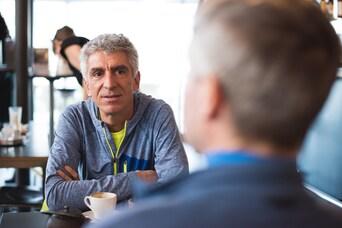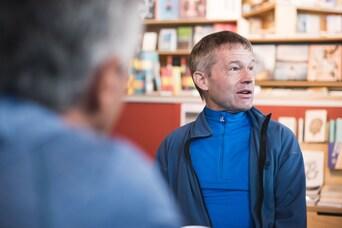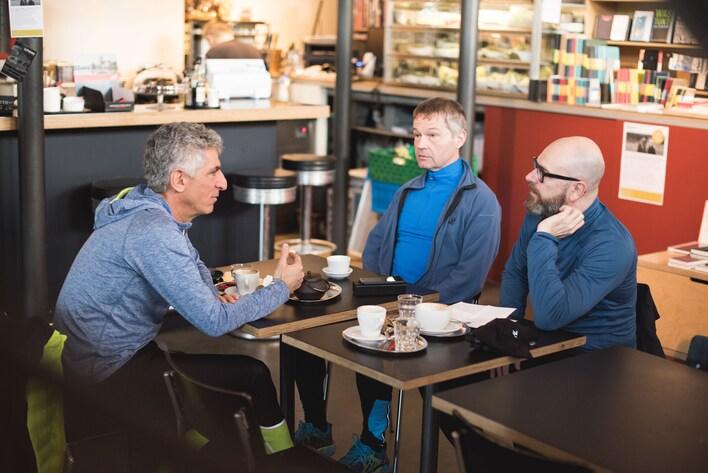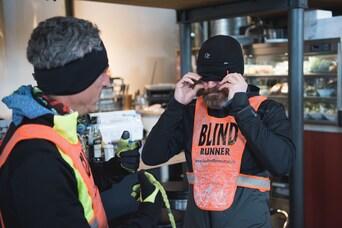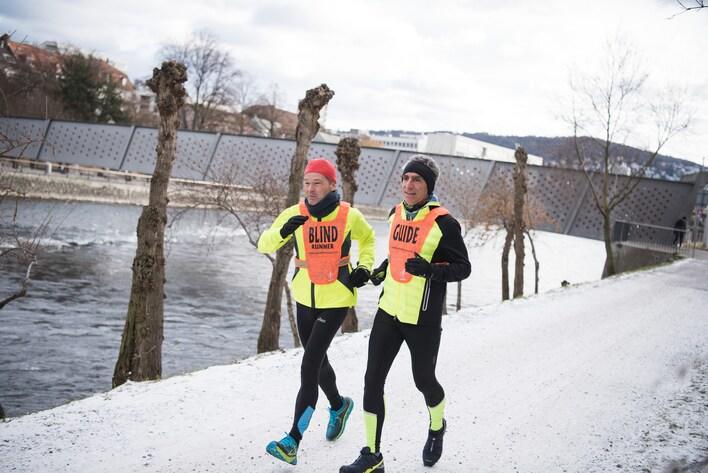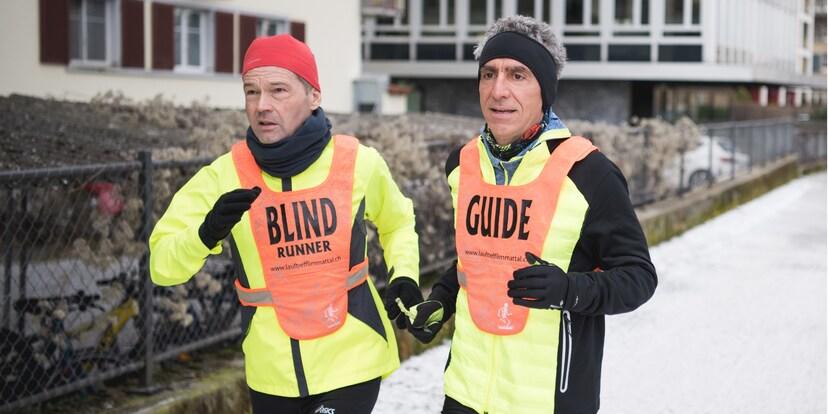His concentrated pervasive look is the first thing I notice about him. When I'm sitting across from him, I somehow already sense what he means when he says later in the conversation: "I just have to do this." Meet Mike Baer, running guide.
It's cold outside, loud inside at Sphères. Here I meet Mike Bär and Hans-Peter Schmid at the end of January for a talk. In the little free time he has, the banker accompanies visually impaired runners for the Limmattal running club as a guide. Hans-Peter, from Wollishofen, has been with him for three years. He became completely blind in his youth. Vision today: zero.
Mike Bär:
Hans-Peter Schmid:
What made you want to walk as a guide with visually impaired people?
Mike Bär, Guide: For the first time I saw tandem runners at a marathon in the USA. There were four or five teams from China running as tandems. That fascinated me completely. Half a year later I took part in a marathon in the Atacama Desert at about 4,500 meters above sea level. At that time I came across a video with a visually impaired runner from Ireland, who had competed the year before. It was overwhelming to watch. Later on I also learned that her guide had completely broken down and that both of them had fallen again and again on the rough terrain. At some point the Irish girl had enough. She left her guide and simply asked another runner if he could lead her to the finish line. Which he did. This story made clear to me that I wanted to do the same. Oh, what am I saying, I just had to do it. Back in Switzerland I found the running group Limmattal.
Mike has now been accompanying Hans-Peter Schmid on his runs for about three years. During this time a friendship has developed between the two men. I want to know from Mike what the specific task of a guide is. "Simply put, to run with a visually impaired person," he answers. With the two of them though, this continues on a much higher level. Mike also accompanies Hans-Peter at competitions.
How does a day of competition go?
It is important to prepare properly for the race: where do we run, what does the terrain look like, where do we pick up our start number, where do we change clothes, where can we warm up? How do we get to the start and how do we get back home after the race? All the organizational questions need to be answered.
And in the competition itself?
The most important thing is not to fall. That is everything. And then there are the "normal" problems of every runner. We wear orange vests, which identifies Hans-Peter as a runner with visual impairment and me as a guide. Nevertheless there are drivers who do not stop at pedestrian crossings. There are cyclists, people with prams, people with dogs - nobody avoids us. Then there are obstacles like roots in the ground, curbs, traffic dividers and so on. So it is not always easy to get through without an accident. The worst thing would be if Hans-Peter were to fall, which, thank God, has not been the case so far.
Where do you train?
We are often at Greifensee. One lap there is 17 kilometres and it runs comfortably on a good surface. We haven't been in the city for a long time. In summer there are simply too many people. And when we are in town, we often run along the lake basin.
Talk shop:
They have a good pace when they run. Hans-Peter manages the half-marathon in under 1:45:00. His best time over 42,195 kilometres is 3:54:00. With such fast times even Guide Mike reaches his limits. After all, he doesn't "only" have to run, he has to lead Hans-Peter safely to the finish. The two of them smile when I want to know who has to be considerate of whom. The diplomatic answer is that it's up to the form on the day.
Where did you complete your training as a guide?
At the "Lauftreff Limmattal".
And what does that look like?
The training consists of a one-day basic course and two refresher courses. There is a theoretical and a practical part. Here you run with different glasses that simulate different eye diseases. For example, you only perceive light/dark or the field of vision is severely restricted. There you have the feeling of looking through a tube. Or you just can't see anything anymore. After these three days of training you will run with a visually impaired person and a guide who will coach you. Afterwards you will start.
What are the biggest difficulties?
There are many things we underestimate. Just a curb can be a big hurdle for a visually impaired person. The correct and above all timely announcement of these obstacles is not easy. Let us stick to this example. I have to make sure that Hans-Peter always walks over a curb at a 90-degree angle, otherwise he will stumble. So always run straight towards such an obstacle, never diagonally. You learn such things in training. But you know what, Patrick? Here's a blindfold. I'll show you.
It's getting dark:
Watch out, it's about to get slippery:
Just let go
Okay, I'm gonna put the blindfold on and go into Mike's care for a few minutes. We run along the Limmat and are connected by a short string. We try to walk with about the same stride length and as synchronous as possible. Mike always tells me what is coming next. "Here it is about to get slippery, a cyclist is coming towards us. Here there are playing dogs, now we have to walk some steps instead of running." That sort of thing.
On the way back we walk along the road. "Now you'll hear the tram in a minute. Now we slow down, people get off, now we have to stop for a moment. Now we keep walking." Then we're back at Sphères. And I'll have a new experience. Wow. I feel a deep sense of gratitude that Mike has guided me safely around the world. I let go and he took over. For a brief moment I have to hold back my emotions, so that I don't just fall around his neck.
Speaking of which, how about trust? After all, Hans-Peter puts his health into the hands of another person. "At the beginning it was much more stressful for Mike than for me," he says calmly. He is simply experienced in this respect. During his studies, he competed in cross-country skiing with guides and had already skied with various guides before Mike. But of course, you'd be giving yourself over to another person. There is no way around that. But with him he now had a guide who could keep up with him. Finally, he says laughing.
«On April 15th, we're running the Boston Marathon.»
However, on short tempo runs Hans-Peter is runnong with another guide, Sandra. The young woman is even faster than Mike. And on ultra long runs Hans-Peter can count on the services of a triathlete. So he has the right guide for every purpose.
No desire to be on the road for five hours
So Hans-Peter has to back off sooner, Mike?
Yeah, on good days that can happen. If he's well-trained and injury-free, he'll be faster than me. But we both can run a marathon or half marathon in a decent time. Neither of us wants to be on the road for five hours or so.
And Hans-Peter is so fast that he has qualified for this year's Boston Marathon. The anticipation of this highlight is written all over both runners' faces.
Portrait on Galaxus from the March the 6th 2019
https://www.galaxus.ch/de/page/lass-mich-fuer-dich-sehen-11102


